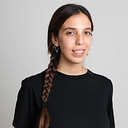Elevate Talks: Setanta
Èric Coll and Sergio Ibañez decided to found Setanta in 2007. At that time, creating a studio that specialized on editorial design was a pretty crazy thing to do. Now, 11 years later, they work with a wide variety of projects from top-notch clients such as Blackie Books (editorial design and logo), Canada editorial, Conde Nast Italia and El País. Maybe the digital world didn’t terminate the editorial one after all.
Could you introduce yourself, please?
Èric Coll, Barcelona, 1973. I am an art director and graphic designer. In 2007, we founded Setanta studio together with Sergio Ibáñez.
How would you describe Setanta?
Setanta is a studio who specializes on solving editorial design projects, although we also work with clients who ask for branding and communication services.
How is the team organized?
We are a small studio in terms of infrastructure. Basically, a 4-people team. Sergio and I take care of the art direction and project follow-up and two designers help us with the development, completion and implementation of every project.
What is the best about working in Barcelona?
Barcelona is a medium-sized Mediterranean city. Its nature is dynamic and has a high cultural level average.It is a self-critical city that constantly questions what it wants to be and how will it get to be what it wants to be. Barcelona is curious about its environment, this leaves an imprint on its citizens who have learnt to live in a constant development and transformation. They want to participate on what is going on.
Also, the life quality offered by the city is high in terms of weather, distances and culture.
What has inspired you to dedicate yourselves to editorial design?
I don’t know to what extent we chose to do editorial design. Maybe editorial design chose us… Both my partner and I had experience in the publishing world before the studio’s creation. If you like graphic design and you are a curious person (culturally speaking), if you have great affinity for the plastic arts, if you are interested in photography, art, architecture, illustration, poetry, literature, magazines and books as artistic objects, if you are curious and worry about aesthetics (and if you are a bit of a fetishist) and you think that you have something at the top of your lungs to say to the world, then working on editorial design makes absolute sense. It is a mix of all of these disciplines I’ve mentioned.
In which ways did the term “editorial design” change since 2007, when you founded the studio, till now?
When we decided in 2007 that we wanted to create an editorial design studio, our friends, family and colleagues told us that we were crazy. They truly believed that digital platforms would eat out the market of “paper” books and magazines really soon. None of this has happened yet and our day-to-day work reassures that it will probably never happen at all.
Perhaps the distribution, communication and sales channels have changed. Nowadays producing a magazine to sell in kiosks is pretty useless for a private or independent company. But other formulas have emerged and they have favored the creation of editorial products. Regarding aesthetics, graphic design and other creative disciplines, are utterly cool and subject to constant fluctuations depending on what is trending at the moment.
Anyway, Setanta tries hard to escape from that madness and focuses on looking for specific solutions for each individual project. We do not like much the idea of having our “own” graphic aesthetics or style as if we were kind of signing our designs. We believe that every project and every client needs to have their own customized language without renouncing to the contemporary context.
If you had to mention your top 3 projects/works, what would they be?
It is difficult to choose only three projects, it is just like asking a father or mother which son or daughter they love the most. But I’ll list three that have been especially important in our career.
Blackie Books’ literary collection is undoubtedly one of them, due to the nationwide visibility it gave us. The Candy Magazine edited by Luis Venegas gave us the opportunity to work with international photographers and designers. And the collection of books about the Catalan artist Joan Ponç has enhanced our relationship with the local cultural and artistic worlds.
Which are the tools you use the most in day to day?
Pencil, paper, InDesign and emails.
What is your biggest challenge?
Right now we are working on the creative direction and redesign of a magazine for Conde Nast Italia. The first issue is about to be published. Maybe this is one of our biggest challenges, at least it is the one we are dealing with right now, both because of the work itself and the internal management effort it means for a small studio as Setanta.
What would you like to be doing in 12 months?
More art books, for example.
How do you see yourself in 5 years?
We have wanted to edit something of our own for a long time.
Bonus Track: Can you recommend any movie / TV series / record / artist / Instagram account?
Album: El petit de Cal Eril. 2018.
Instagram: @hoy_tal
